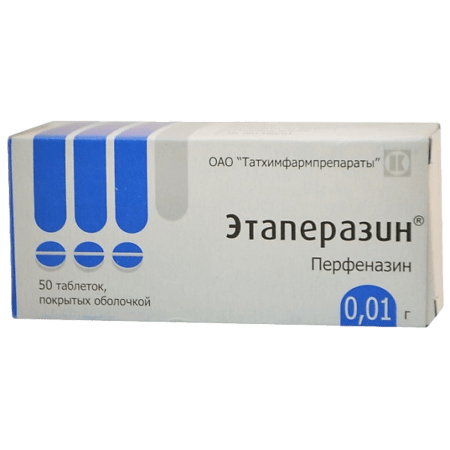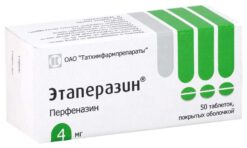No products in the cart.
Etaperazine, 10 mg 50 pcs
€12.28 €10.74
Out of stock
(E-mail when Stock is available)
Description
Psycho-emotional tension, Neurosis, Vomiting, Schizophrenia, Mental disorders, Skin itching, Hiccups
Treatment of psychotic disorders, especially hyperactivity and agitation, schizophrenia;
Indications
Indications
Treatment of psychotic disorders, especially hyperactivity and agitation, schizophrenia;
Pharmacological effect
Pharmacological effect
Antipsychotic drug (neuroleptic), piperazine derivative of phenothiazine.
Special instructions
Special instructions
Perphenazine should be used with caution in case of hypersensitivity to other phenothiazine drugs.
Phenothiazines are used with extreme caution in patients with pathological changes in the blood picture, liver dysfunction, alcohol intoxication, Reye’s syndrome, as well as breast cancer, cardiovascular diseases, predisposition to the development of glaucoma, Parkinson’s disease, gastric and duodenal ulcers, urinary retention, chronic respiratory diseases (especially in children), epileptic seizures, vomiting; in elderly patients (increased risk of excessive sedation and hypotensive effects), in depleted and weakened patients.
The development of tardive dyskinesia during the use of perphenazine is more likely in elderly patients, women and those with brain damage. Parkinsonian extrapyramidal reactions are more often observed in elderly patients, dystonic extrapyramidal reactions – in younger people. Symptoms of these disorders may occur in the first few days of treatment or after long-term therapy and may recur even after a single dose.
In case of hyperthermia, which is one of the elements of NMS, perphenazine should be discontinued immediately.
The simultaneous use of phenothiazines with absorbent antidiarrheals should be avoided.
During the treatment period, avoid drinking alcohol.
Recommendations for the use of perphenazine in children under 12 years of age have not been established. Children, especially those with acute illness, are more likely to develop extrapyramidal symptoms when using phenothiazines.
Impact on the ability to drive vehicles and operate machinery
It should be used with caution in patients engaged in potentially hazardous activities that require a high speed of psychomotor reactions.
Active ingredient
Active ingredient
Perphenazine
Composition
Composition
Active substance:
Contraindications
Contraindications
Cirrhosis, hepatitis, hemolytic jaundice, nephritis, hematopoietic disorders, myxedema, progressive systemic diseases of the brain and spinal cord, decompensated heart disease, thromboembolic diseases, late stages of bronchiectasis, pregnancy, lactation, hypersensitivity to perphenazine.
Side Effects
Side Effects
From the central nervous system: drowsiness, akathisia, blurred vision, dystonic extrapyramidal reactions, parkinsonian extrapyramidal reactions.
From the liver: rarely – cholestatic jaundice.
From the hematopoietic system: rarely – agranulocytosis.
Metabolic disorders: rarely – heat stroke, melanosis.
Allergic reactions: rarely – skin rash accompanied by contact dermatitis.
Dermatological reactions: rarely – photosensitivity.
Effects due to anticholinergic action: possible dry mouth, accommodation disturbances, constipation, difficulty urinating.
Interaction
Interaction
When used simultaneously with drugs that have a depressant effect on the central nervous system, with ethanol and ethanol-containing drugs, increased depression of the central nervous system and respiratory function is possible.
When used simultaneously with anticonvulsants, the threshold for convulsive readiness may be lowered; with drugs for the treatment of hyperthyroidism, the risk of developing agranulocytosis increases.
When used simultaneously with drugs that cause extrapyramidal reactions, an increase in the frequency and severity of extrapyramidal disorders is possible.
When used simultaneously with drugs that cause arterial hypotension, severe orthostatic hypotension is possible.
When used simultaneously with drugs that have anticholinergic effects, their anticholinergic effects may be enhanced, while the antipsychotic effect of the antipsychotic may decrease.
When used simultaneously with tricyclic antidepressants, maprotiline, and MAO inhibitors, the risk of developing NMS increases.
With the simultaneous use of antacids, antiparkinsonian drugs, lithium salts, the absorption of phenothiazines is impaired.
With simultaneous use, it is possible to reduce the effect of amphetamines, levodopa, clonidine, guanethidine, epinephrine.
When used simultaneously with fluoxetine, extrapyramidal symptoms and dystonia may develop.
With simultaneous use, the vasoconstrictor effect of ephedrine may be weakened.
Storage conditions
Storage conditions
In a dry place, protected from light
Shelf life
Shelf life
3 years
Manufacturer
Manufacturer
Tatchimpharmpreparaty, Russia
Additional information
| Shelf life | 3 years |
|---|---|
| Conditions of storage | In a dry, light-protected place |
| Manufacturer | Tatkhimpharmpreparaty, Russia |
| Medication form | pills |
| Brand | Tatkhimpharmpreparaty |
Other forms…
Related products
Buy Etaperazine, 10 mg 50 pcs with delivery to USA, UK, Europe and over 120 other countries.















